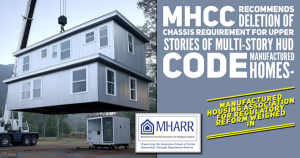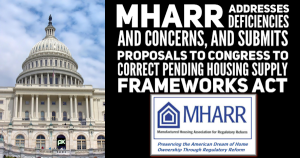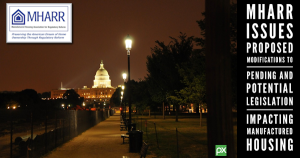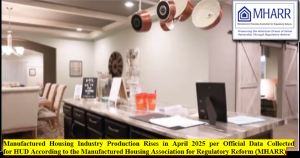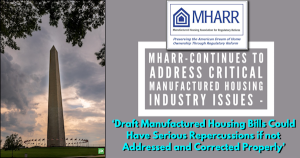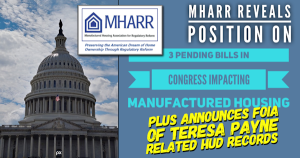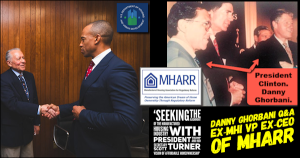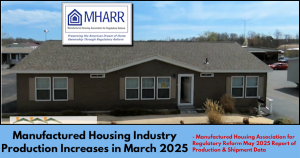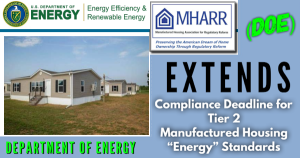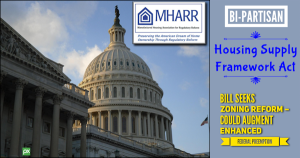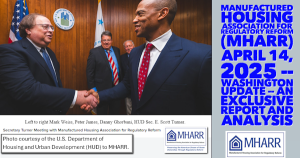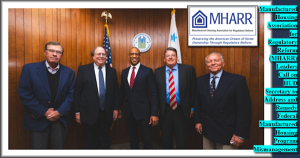HUD Guidance, MH Retail “Essential” Status, Park Models, More in Manufactured Housing Washington Update 4.22.2020
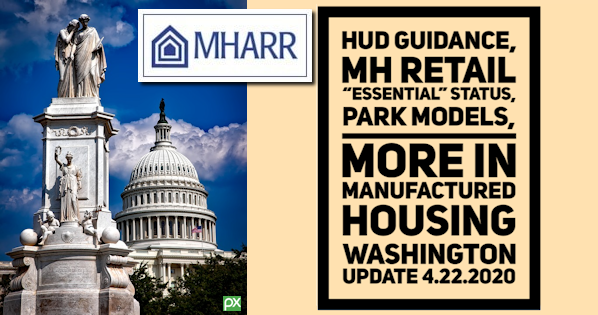
- MHARR REITERATES CALL TO RETRACT HUD “GUIDANCE”
- HUD MISAPPLIES TRUMP EXECUTIVE ORDERS
- HOUSING DEEMED “ESSENTIAL” DURING COVID-19 EMERGENCY
- MHARR SEEKS FEDERAL “ESSENTIAL” STATUS FOR MH RETAILERS
- HUD ISSUES INDUSTRY-WIDE AC LETTER FOR WINDOWS
- HUD ADVANCES STUDY OF PARK MODEL EXEMPTION
MHARR CALLS FOR RETRACTION OF HUD SUB-REGULATORY “GUIDANCE”
MHARR, in March 30, 2020 written comments filed in response to HUD’s proposed “Third Set” of revisions to the Part 3280 Manufactured Housing Construction and Safety Standards recommended by the statutory Manufactured Housing Consensus Committee (MHCC), has reiterated its longstanding call for the retraction of all sub-regulatory manufactured housing “guidance” documents issued by the Department without the prior MHCC review and notice and comment procedures mandated by the Manufactured Housing Improvement Act of 2000.
MHARR’s position on this matter is – and has been — that any substantive change to: (1) the Part 3280 federal standards; (2) the Part 3282 Procedural and Enforcement Regulations; (3) the interpretation of those standards and regulations, or (4) HUD policies, procedures, or practices relating to the standards, their enforcement or the statutorily-defined “monitoring” process, must be adopted via prior MHCC review and recommendation, and notice and comment rulemaking in accordance with section 604(a) and 604(b) of the 2000 reform law. And now the Trump Administration has expressly adopted the same position through Executive Orders (EOs) 13891 (“Promoting the Rule of Law Through Improved Agency Guidance Documents”) and 13892 (“Promoting the Rule of Law Through Transparency and Fairness in Civil Administrative Enforcement and Adjudication’) issued on October 9, 2019. These EOs provide, in relevant part, that unpublished guidance documents “may not be used to impose new standards of conduct on persons outside of the Executive Branch” and further require that “agencies treat guidance documents as non-binding both in law and in practice.” (Emphasis added).
Based on the express terms of these Executive Orders, each of the numerous so-called “guidance” documents issued by the HUD Office of Manufactured Housing Programs (OMHP) without both prior MHCC review and notice and comment rulemaking since the effective date of the 2000 reform law (i.e., December 31, 2000) is presumptively non-binding on any regulated party and procedurally invalid. Moreover, while HUD, supposedly in accordance with Section 3 of EO 13891, has listed some 45 Interpretive Bulletins adopted via notice and comment rulemaking since 1976 pursuant to section 604(b) of the law, in a searchable database on its internet website — which it arguably was not required to do (see, article below) — it has not listed any of its other unpublished “guidance” documents, as is affirmatively required by both of the October 9, 2019 Executive Orders. MHARR’s comments, accordingly, call on HUD, among other things, to “publish unequivocal notice in the Federal Register announcing the withdrawal and invalidation of those [“guidance”] documents and advising regulated parties that they are no longer binding or operative in any respect.” More generally, HUD’s full compliance with EOs 13891, 13892 and the procedural requirements of the 2000 reform law – including the full and proper implementation of section 604(b)(6) – remains a major regulatory priority that MHARR will work to advance with the senior leadership of HUD and the Trump Administration.
With regard to the specific new standards proposed by HUD, MHARR’s comments “generally” support their adoption, but point out that the sudden advancement of certain standards recommended by the MHCC well over a decade ago (e.g., attached and multi-story manufactured homes), but not others of much more recent origin (i.e., multi-unit/multi-family manufactured homes), raises serious questions as to whether HUD is seeking to illicitly aid and abet Fannie Mae and Freddie Mac in their ongoing effort to divert and distort the “Duty to Serve Underserved Markets” (DTS) by shifting DTS away from market-significant levels of support for mainstream, affordable HUD Code manufactured homes and toward larger, more elaborate and much-less-affordable homes that are more like the site-built homes that both of the finance entities would prefer to deal with. Having raised this issue, MHARR will carefully monitor any final standards resulting from this notice to determine whether they unfairly promote the interests of the industry’s largest corporate conglomerates or unfairly burden the interests of smaller industry businesses.
HUD MISAPPLIES PRESIDENT TRUMP’S EXECUTIVE ORDERS
As noted above, Executive Order 13891 (“Promoting the Rule of Law Through Improved Agency Guidance Documents”) specifically provides that federal agency “guidance” documents issued without notice and comment rulemaking (and other statutorily-required procedures) are non-binding and advisory only. Nevertheless, Section 3(a) of that Order, “Ensuring Transparent Use of Guidance Documents,” requires that each federal agency “establish or maintain on its website a single, searchable indexed database that contains or links to all guidance documents in effect from such agency….” Section 3(b) of that order, in turn, requires each Executive Branch agency, within the same time period, to “review its guidance documents and, consistent with applicable law, rescind those guidance documents that it determines should no longer be in effect.” (Emphasis added)
Pursuant to these dual mandates, HUD, on March 4, 2020 published a Federal Register notice announcing the creation of an internet “portal” for advisory “guidance” documents. As initially published, that portal contained no references or links to any OMHP documents regarding manufactured housing. MHARR, therefore, in accordance with Section 3(b) of EO 13891, sent a communication to the HUD program administrator, stating its understanding that the program’s failure to comply with the requirements of EO 13891 effectively constituted the withdrawal of all such OMHP guidance documents, even as non-binding advisory-only statements.
HUD subsequently responded to this communication by posting, on its “guidance portal,” no specifically-denominated “guidance documents” (at least 13 of which have been issued since 2010), but rather, a list of 45 Interpretive Bulletins (IBs) issued by OMHP since 1976, pursuant to Section 604(b)(2) of the federal manufactured housing law as amended. That section, in relevant part, requires that all proposed manufactured housing Interpretive Bulletins be published for notice and comment in the Federal Register “in accordance with section 553 of Title 5” (i.e., the federal Administrative Procedure Act — APA) and, in fact, each of the 45 IBs listed on the portal has been previously published in accordance with that section of the law (as amended) and the APA. As was noted by MHARR in its “Third Set of Standards” comments (see article above), however, a document adopted through notice and comment procedures does not constitute a “guidance” document for purposes of EO 13891. Thus, Section 2 of the EO defines a “guidance document” as “an agency statement of general applicability, intended to have future effect on the behavior of regulated parties, that sets forth a policy on a statutory, regulatory, or technical issue, or an interpretation of a statute or regulation, but does not include … rules promulgated pursuant to notice and comment under section 553 of Title 5, United States Code, or similar statutory provisions.”
The upshot of the foregoing is that OMHP has published, on the HUD “guidance portal,” IBs adopted via notice and comment rulemaking that are not “guidance” documents within the meaning of EO 13891 (and therefore did not have to be listed on the “guidance portal”). At the same time, it has failed to list or identify on that portal, other OMHP documents that do (or could) in fact, meet the definition of a “guidance document” as set forth in the EO. Consequently, in accordance with the terms of EOs 13891 and 13892, those non-published, non-listed OMHP “guidance documents” are, as MHARR continues to maintain, no longer operative, and should be expressly so-designated by HUD as requested by MHARR in its “Third Set” written comments.
FEDERAL GUIDANCE DEEMS RESIDENTIAL CONSTRUCTION “ESSENTIAL”
MHARR, in a March 24, 2020 communication to HUD Secretary Ben Carson, requested that manufactured housing production and related HUD Code industry activity be deemed “essential” for purposes of federal and state-level COVID-19 “Stay at Home” orders. Citing the industry’s “long history of ‘stepping-up’ to meet the nation’s housing needs in times of crisis and emergency,” MHARR stated: “In order to maintain the industry’s essential infrastructure … to the greatest possible degree, to meet [the existing] and future housing needs of the nation, we urge you to take all steps necessary and proper to: (1) ensure that the production, sale, transportation and installation of federally-regulated manufactured homes are treated as ‘essential’ economic activity for all purposes at all levels of government….” (Emphasis added).
Consistent with this request, federal guidance issued by the Cybersecurity and Infrastructure Security Agency (CISA) of the Department of Homeland Security (DHS) on March 28, 2020, specifically designated “workers supporting the construction of housing” as being part of the nation’s “essential” workforce and, therefore, advised that such workers be deemed exempt from state (and/or local level) COVID-19 closure orders.
With this broad phrasing, the CISA federal guidance has been construed and treated in most states (but not all, see, article below) as exempting both the construction of HUD Code manufactured housing and related industry activities from “Stay at Home” and other similar COVID-19 response orders, as those activities, collectively, are necessary to maintaining the nation’s supply of inherently affordable housing. Given the symbiotic and inter-related nature of the various segments of the industry in both the production and post-production sectors, such treatment is not only proper but necessary to the overarching goal of maintaining the availability of affordable housing and homeownership. MHARR, therefore, continues to urge all levels of government to treat all segments of the HUD Code manufactured housing industry, and all workers within those sectors, as being “essential” to the national economy and the nation’s fundamental infrastructure.
MHARR REQUESTS “ESSENTIAL” FEDERAL DESIGNATION FOR RETAILERS
Based on concerns that HUD Code manufactured housing retailers may not be exempted from COVID-19 “Stay at Home” orders issued by governors in certain states, MHARR, in an April 3, 2020 communication to HUD Secretary Ben Carson and U.S. Cybersecurity and Infrastructure Security Agency (CISA) Director Christopher C. Krebs, urged that CISA’s March 28, 2020 guidance regarding “essential” workforce members be clarified to specifically include workers involved in “the manufactured housing industry’s supply and distribution channels.”
MHARR, in support of this request, stated: “While we construe [the] language [of the March 28, 2020 CISA guidance] – and believe that it was fully intended by CISA – to include both the production and sale of HUD Code manufactured homes to American consumers (as well as other necessary related functions, including the transportation and installation of HUD-regulated manufactured homes), the language of some stay-at-home orders could, unfortunately, be interpreted as not including manufactured housing retail establishments within their definition of ‘essential’ economic or infrastructure activity. Within the unique context of the manufactured housing industry, however, where independent retailers are an indispensable component of the chain of distribution between producers and consumers, it is essential both for American consumers of affordable housing and all other sectors of the HUD Code industry that local-level manufactured housing retailers be permitted to remain open and fully-operational.” (Emphasis added).
And now, in the most recent CISA guidance, issued on April 17, 2020, language has been added to the guidance document’s “logistics” section that is consistent with MHARR’s request addressing the industry’s “chain of distribution.” Specifically, item 13 of the updated CISA “logistics” guidance includes, as part of the nation’s “essential” workforce “Manufacturers and distributors … needed to support … distribution operations and other critical infrastructure needs.” (Emphasis added). The new language added in the April 17, 2020 update, including workers needed to support distribution operations related to “other critical infrastructure needs,” is now clearly broad enough to encompass manufactured housing retail operations, insofar as residential “housing construction” has already been deemed to be an “essential” infrastructure activity.
This new language can and should provide an additional basis and rationale for the full exemption of manufactured housing construction, transportation, retailing and installation activities in all states, and a “comfort zone” for authorities in certain to begin relaxing unduly restrictive mandates affecting the HUD Code industry and its consumers.
HUD ISSUSES INDUSTRY-WIDE AC LETTER FOR WINDOWS
The HUD Office of Manufactured Housing Programs, on April 16, 2020, issued an industry-wide Alternative Construction (AC) letter (20-IW1-AC) for manufactured home windows in response to supply-chain issues resulting from the current COVID-19 emergency. Noting that “the supply chain is currently unable to supply windows that conform to certain standards within 24 C.F.R. Part 3280” the AC permits HUD Code manufacturers to build an unlimited number of homes with alternative windows, until December 31, 2020, and states that “HUD will not take enforcement action against [manufacturers] for violations of 24 C.F.R. 3280.403(b)(1), (e), (e)(1)-(2) and 3280.404(b), insofar as these regulations reference a specific reference standard” subject to certain procedural requirements set out in detail in the AC. Unlike typical AC situations, this “industry-wide” AC, according to HUD, does “not require individual manufacturers to request [specific] approval” of a particular type of window.
Given the possibility of other manufactured housing supply chain disruptions resulting from government closure orders or otherwise related to COVID-19 response measures, MHARR will closely monitor the need for any similar AC or related regulatory relief.
HUD ADVANCES STUDY RELATED TO PARK MODEL EXEMPTION
HUD is seeking permission from the Office of Management and Budget (OMB) to continue an information collection activity related to Park Model Recreational Vehicles (PMRVs) that are claimed to be exempt from regulation pursuant to HUD’s manufactured housing standards pursuant to 24 C.F.R. 3282.15.
In a notice published in the Federal Register on April 10, 2020, HUD seeks continuing authority from OMB to study compliance with the notice requirements of 24 C.F.R. 3282.15(c) by PMRV manufacturers with respect to PMRVs that are claimed to be exempt from the HUD Federal Manufactured Housing Construction and Safety Standards set forth at 24 C.F.R. 3280.
Pursuant to 24 C.F.R. 3282.15, PMRVs that claim to be exempt from the HUD manufactured housing standards must post a notice in the structure stating that the PMRV is designed only for recreational purposes and is not designed as a primary residence or for permanent occupancy.
In relevant part, though, HUD’s Federal Register notice states that the “current seal” provided by the Recreational Vehicle Industry Association (RVIA) for that purpose “does not satisfy HUD’s standard for the manufacturer’s notice.” Insofar as this information collection activity could potentially lead to new or additional requirements relating to the RV exemption, MHARR will submit appropriate comments to HUD on this matter and continue to closely monitor this issue.
- MHARR REITERATES CALL TO RETRACT HUD “GUIDANCE”
- HUD MISAPPLIES TRUMP EXECUTIVE ORDERS
- HOUSING DEEMED “ESSENTIAL” DURING COVID-19 EMERGENCY
- MHARR SEEKS FEDERAL “ESSENTIAL” STATUS FOR MH RETAILERS
- HUD ISSUES INDUSTRY-WIDE AC LETTER FOR WINDOWS
- HUD ADVANCES STUDY OF PARK MODEL EXEMPTION
MHARR CALLS FOR RETRACTION OF HUD SUB-REGULATORY “GUIDANCE”
MHARR, in March 30, 2020 written comments filed in response to HUD’s proposed “Third Set” of revisions to the Part 3280 Manufactured Housing Construction and Safety Standards recommended by the statutory Manufactured Housing Consensus Committee (MHCC), has reiterated its longstanding call for the retraction of all sub-regulatory manufactured housing “guidance” documents issued by the Department without the prior MHCC review and notice and comment procedures mandated by the Manufactured Housing Improvement Act of 2000.
MHARR’s position on this matter is – and has been — that any substantive change to: (1) the Part 3280 federal standards; (2) the Part 3282 Procedural and Enforcement Regulations; (3) the interpretation of those standards and regulations, or (4) HUD policies, procedures, or practices relating to the standards, their enforcement or the statutorily-defined “monitoring” process, must be adopted via prior MHCC review and recommendation, and notice and comment rulemaking in accordance with section 604(a) and 604(b) of the 2000 reform law. And now the Trump Administration has expressly adopted the same position through Executive Orders (EOs) 13891 (“Promoting the Rule of Law Through Improved Agency Guidance Documents”) and 13892 (“Promoting the Rule of Law Through Transparency and Fairness in Civil Administrative Enforcement and Adjudication’) issued on October 9, 2019. These EOs provide, in relevant part, that unpublished guidance documents “may not be used to impose new standards of conduct on persons outside of the Executive Branch” and further require that “agencies treat guidance documents as non-binding both in law and in practice.” (Emphasis added).
Based on the express terms of these Executive Orders, each of the numerous so-called “guidance” documents issued by the HUD Office of Manufactured Housing Programs (OMHP) without both prior MHCC review and notice and comment rulemaking since the effective date of the 2000 reform law (i.e., December 31, 2000) is presumptively non-binding on any regulated party and procedurally invalid. Moreover, while HUD, supposedly in accordance with Section 3 of EO 13891, has listed some 45 Interpretive Bulletins adopted via notice and comment rulemaking since 1976 pursuant to section 604(b) of the law, in a searchable database on its internet website — which it arguably was not required to do (see, article below) — it has not listed any of its other unpublished “guidance” documents, as is affirmatively required by both of the October 9, 2019 Executive Orders. MHARR’s comments, accordingly, call on HUD, among other things, to “publish unequivocal notice in the Federal Register announcing the withdrawal and invalidation of those [“guidance”] documents and advising regulated parties that they are no longer binding or operative in any respect.” More generally, HUD’s full compliance with EOs 13891, 13892 and the procedural requirements of the 2000 reform law – including the full and proper implementation of section 604(b)(6) – remains a major regulatory priority that MHARR will work to advance with the senior leadership of HUD and the Trump Administration.
With regard to the specific new standards proposed by HUD, MHARR’s comments “generally” support their adoption, but point out that the sudden advancement of certain standards recommended by the MHCC well over a decade ago (e.g., attached and multi-story manufactured homes), but not others of much more recent origin (i.e., multi-unit/multi-family manufactured homes), raises serious questions as to whether HUD is seeking to illicitly aid and abet Fannie Mae and Freddie Mac in their ongoing effort to divert and distort the “Duty to Serve Underserved Markets” (DTS) by shifting DTS away from market-significant levels of support for mainstream, affordable HUD Code manufactured homes and toward larger, more elaborate and much-less-affordable homes that are more like the site-built homes that both of the finance entities would prefer to deal with. Having raised this issue, MHARR will carefully monitor any final standards resulting from this notice to determine whether they unfairly promote the interests of the industry’s largest corporate conglomerates or unfairly burden the interests of smaller industry businesses.
HUD MISAPPLIES PRESIDENT TRUMP’S EXECUTIVE ORDERS
As noted above, Executive Order 13891 (“Promoting the Rule of Law Through Improved Agency Guidance Documents”) specifically provides that federal agency “guidance” documents issued without notice and comment rulemaking (and other statutorily-required procedures) are non-binding and advisory only. Nevertheless, Section 3(a) of that Order, “Ensuring Transparent Use of Guidance Documents,” requires that each federal agency “establish or maintain on its website a single, searchable indexed database that contains or links to all guidance documents in effect from such agency….” Section 3(b) of that order, in turn, requires each Executive Branch agency, within the same time period, to “review its guidance documents and, consistent with applicable law, rescind those guidance documents that it determines should no longer be in effect.” (Emphasis added)
Pursuant to these dual mandates, HUD, on March 4, 2020 published a Federal Register notice announcing the creation of an internet “portal” for advisory “guidance” documents. As initially published, that portal contained no references or links to any OMHP documents regarding manufactured housing. MHARR, therefore, in accordance with Section 3(b) of EO 13891, sent a communication to the HUD program administrator, stating its understanding that the program’s failure to comply with the requirements of EO 13891 effectively constituted the withdrawal of all such OMHP guidance documents, even as non-binding advisory-only statements.
HUD subsequently responded to this communication by posting, on its “guidance portal,” no specifically-denominated “guidance documents” (at least 13 of which have been issued since 2010), but rather, a list of 45 Interpretive Bulletins (IBs) issued by OMHP since 1976, pursuant to Section 604(b)(2) of the federal manufactured housing law as amended. That section, in relevant part, requires that all proposed manufactured housing Interpretive Bulletins be published for notice and comment in the Federal Register “in accordance with section 553 of Title 5” (i.e., the federal Administrative Procedure Act — APA) and, in fact, each of the 45 IBs listed on the portal has been previously published in accordance with that section of the law (as amended) and the APA. As was noted by MHARR in its “Third Set of Standards” comments (see article above), however, a document adopted through notice and comment procedures does not constitute a “guidance” document for purposes of EO 13891. Thus, Section 2 of the EO defines a “guidance document” as “an agency statement of general applicability, intended to have future effect on the behavior of regulated parties, that sets forth a policy on a statutory, regulatory, or technical issue, or an interpretation of a statute or regulation, but does not include … rules promulgated pursuant to notice and comment under section 553 of Title 5, United States Code, or similar statutory provisions.”
The upshot of the foregoing is that OMHP has published, on the HUD “guidance portal,” IBs adopted via notice and comment rulemaking that are not “guidance” documents within the meaning of EO 13891 (and therefore did not have to be listed on the “guidance portal”). At the same time, it has failed to list or identify on that portal, other OMHP documents that do (or could) in fact, meet the definition of a “guidance document” as set forth in the EO. Consequently, in accordance with the terms of EOs 13891 and 13892, those non-published, non-listed OMHP “guidance documents” are, as MHARR continues to maintain, no longer operative, and should be expressly so-designated by HUD as requested by MHARR in its “Third Set” written comments.
FEDERAL GUIDANCE DEEMS RESIDENTIAL CONSTRUCTION “ESSENTIAL”
MHARR, in a March 24, 2020 communication to HUD Secretary Ben Carson, requested that manufactured housing production and related HUD Code industry activity be deemed “essential” for purposes of federal and state-level COVID-19 “Stay at Home” orders. Citing the industry’s “long history of ‘stepping-up’ to meet the nation’s housing needs in times of crisis and emergency,” MHARR stated: “In order to maintain the industry’s essential infrastructure … to the greatest possible degree, to meet [the existing] and future housing needs of the nation, we urge you to take all steps necessary and proper to: (1) ensure that the production, sale, transportation and installation of federally-regulated manufactured homes are treated as ‘essential’ economic activity for all purposes at all levels of government….” (Emphasis added).
Consistent with this request, federal guidance issued by the Cybersecurity and Infrastructure Security Agency (CISA) of the Department of Homeland Security (DHS) on March 28, 2020, specifically designated “workers supporting the construction of housing” as being part of the nation’s “essential” workforce and, therefore, advised that such workers be deemed exempt from state (and/or local level) COVID-19 closure orders.
With this broad phrasing, the CISA federal guidance has been construed and treated in most states (but not all, see, article below) as exempting both the construction of HUD Code manufactured housing and related industry activities from “Stay at Home” and other similar COVID-19 response orders, as those activities, collectively, are necessary to maintaining the nation’s supply of inherently affordable housing. Given the symbiotic and inter-related nature of the various segments of the industry in both the production and post-production sectors, such treatment is not only proper but necessary to the overarching goal of maintaining the availability of affordable housing and homeownership. MHARR, therefore, continues to urge all levels of government to treat all segments of the HUD Code manufactured housing industry, and all workers within those sectors, as being “essential” to the national economy and the nation’s fundamental infrastructure.
MHARR REQUESTS “ESSENTIAL” FEDERAL DESIGNATION FOR RETAILERS
Based on concerns that HUD Code manufactured housing retailers may not be exempted from COVID-19 “Stay at Home” orders issued by governors in certain states, MHARR, in an April 3, 2020 communication to HUD Secretary Ben Carson and U.S. Cybersecurity and Infrastructure Security Agency (CISA) Director Christopher C. Krebs, urged that CISA’s March 28, 2020 guidance regarding “essential” workforce members be clarified to specifically include workers involved in “the manufactured housing industry’s supply and distribution channels.”
MHARR, in support of this request, stated: “While we construe [the] language [of the March 28, 2020 CISA guidance] – and believe that it was fully intended by CISA – to include both the production and sale of HUD Code manufactured homes to American consumers (as well as other necessary related functions, including the transportation and installation of HUD-regulated manufactured homes), the language of some stay-at-home orders could, unfortunately, be interpreted as not including manufactured housing retail establishments within their definition of ‘essential’ economic or infrastructure activity. Within the unique context of the manufactured housing industry, however, where independent retailers are an indispensable component of the chain of distribution between producers and consumers, it is essential both for American consumers of affordable housing and all other sectors of the HUD Code industry that local-level manufactured housing retailers be permitted to remain open and fully-operational.” (Emphasis added).
And now, in the most recent CISA guidance, issued on April 17, 2020, language has been added to the guidance document’s “logistics” section that is consistent with MHARR’s request addressing the industry’s “chain of distribution.” Specifically, item 13 of the updated CISA “logistics” guidance includes, as part of the nation’s “essential” workforce “Manufacturers and distributors … needed to support … distribution operations and other critical infrastructure needs.” (Emphasis added). The new language added in the April 17, 2020 update, including workers needed to support distribution operations related to “other critical infrastructure needs,” is now clearly broad enough to encompass manufactured housing retail operations, insofar as residential “housing construction” has already been deemed to be an “essential” infrastructure activity.
This new language can and should provide an additional basis and rationale for the full exemption of manufactured housing construction, transportation, retailing and installation activities in all states, and a “comfort zone” for authorities in certain to begin relaxing unduly restrictive mandates affecting the HUD Code industry and its consumers.
HUD ISSUSES INDUSTRY-WIDE AC LETTER FOR WINDOWS
The HUD Office of Manufactured Housing Programs, on April 16, 2020, issued an industry-wide Alternative Construction (AC) letter (20-IW1-AC) for manufactured home windows in response to supply-chain issues resulting from the current COVID-19 emergency. Noting that “the supply chain is currently unable to supply windows that conform to certain standards within 24 C.F.R. Part 3280” the AC permits HUD Code manufacturers to build an unlimited number of homes with alternative windows, until December 31, 2020, and states that “HUD will not take enforcement action against [manufacturers] for violations of 24 C.F.R. 3280.403(b)(1), (e), (e)(1)-(2) and 3280.404(b), insofar as these regulations reference a specific reference standard” subject to certain procedural requirements set out in detail in the AC. Unlike typical AC situations, this “industry-wide” AC, according to HUD, does “not require individual manufacturers to request [specific] approval” of a particular type of window.
Given the possibility of other manufactured housing supply chain disruptions resulting from government closure orders or otherwise related to COVID-19 response measures, MHARR will closely monitor the need for any similar AC or related regulatory relief.
HUD ADVANCES STUDY RELATED TO PARK MODEL EXEMPTION
HUD is seeking permission from the Office of Management and Budget (OMB) to continue an information collection activity related to Park Model Recreational Vehicles (PMRVs) that are claimed to be exempt from regulation pursuant to HUD’s manufactured housing standards pursuant to 24 C.F.R. 3282.15.
In a notice published in the Federal Register on April 10, 2020, HUD seeks continuing authority from OMB to study compliance with the notice requirements of 24 C.F.R. 3282.15(c) by PMRV manufacturers with respect to PMRVs that are claimed to be exempt from the HUD Federal Manufactured Housing Construction and Safety Standards set forth at 24 C.F.R. 3280.
Pursuant to 24 C.F.R. 3282.15, PMRVs that claim to be exempt from the HUD manufactured housing standards must post a notice in the structure stating that the PMRV is designed only for recreational purposes and is not designed as a primary residence or for permanent occupancy.
In relevant part, though, HUD’s Federal Register notice states that the “current seal” provided by the Recreational Vehicle Industry Association (RVIA) for that purpose “does not satisfy HUD’s standard for the manufacturer’s notice.” Insofar as this information collection activity could potentially lead to new or additional requirements relating to the RV exemption, MHARR will submit appropriate comments to HUD on this matter and continue to closely monitor this issue.

